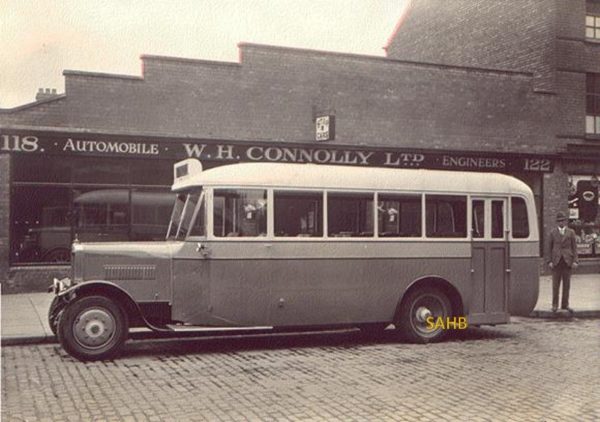
In the absence of two significant clues, it would be a knowledgeable motor historian indeed who was able to identify the make of the chassis of this motor coach. Those clues are the illuminated sign hanging over the frontage of W H Connolly’s showrooms, that reads ‘Star Cars’; and the name of Connolly himself. Coulter & Co, of 51, Chichester Street, had held an agency for Star cars and commercial vehicles in Belfast since 1920. J E Coulter was a great enthusiast for the Wolverhampton marque, and campaigned a tuned-up 12/40hp 2-litre overhead valve Star sports model in speed events in Ulster with some success. The firm’s charge-hand was W H ‘Billy’ Connolly, and it was he who continued competing in the firm’s ‘hot’ Star when Coulter gave up driving after severely injuring a hand in a motor accident. Coulter & Co also held a Ford agency, and Ford policy was to deter their agents from handling other makes of car. So Connolly took over the Star agency and opened premises to trade on his own account at 118 – 122 Donegall Pass in west Belfast – the scene of this photograph.
Star had offered commercial vehicles, mainly on private car chassis, up to the Great War, when the firm devoted much effort to the introduction of a range of medium and heavier, truly ‘commercial’ chassis. Home Office contracts for the war effort were secured, and in the following decade, commercial chassis continued to occupy a smallish part of their vehicle production. Latterly, these focused on the power unit of the 6-cylinder top-of-the-range 20/60hp private car, a 75 x 120mm (3180cc) 6-cylinder with push-rod overhead valves. It was a sophisticated and beautifully-made engine; overkill, really, for commercial purposes, but as the private car chassis sold very slowly, it must have been seen as one way to utilise an existing design. Bored out to 80mm (then 3620cc), the ‘Flyer’ range was inherited by Guy Motors Ltd on their 1928 purchase of the Lisle family’s old firm. Guy persisted with the 6-cylinder ohv Star private cars, restyling them as the ‘Comet’ range, whilst phasing out the Star commercials in favour of their own models over the next 2 to 3 years. Market competition and the Depression finally took their toll, and Guys closed down all of the Star subsidiary in March of 1932.
This small bus would have had a wheelbase of 14ft 2ins, and list price of the chassis was £595. Just five late-type Star commercial chassis are known to exist today, one of which is in New Zealand. Surprisingly, all of the four currently located in the UK originally had been bodied as horse-boxes, so maybe it was a case of ‘only the best’ for customers requiring equestrian transport.







Leave a Comment